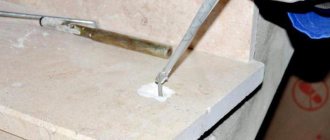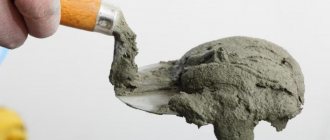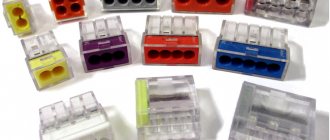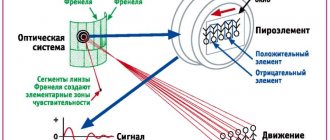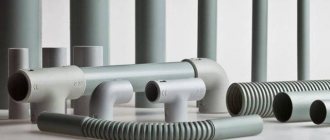Pros and cons of using
Chemical anchor is more versatile compared to rod and wedge anchoring. Suitable for use with most materials, but most suitable for use with hollow or brittle ones. Examples of such materials include: hollow brick, aerated concrete, and so on.
Chemical anchoring is used to install metal structures, frames of door and window openings. After the glue hardens in the hole, strong chemical adhesion occurs, that is, the adhesion of solids due to intermolecular forces, which allows it to withstand heavy loads.
Types of guns for chemical anchors
The use of a cartridge chemical anchor is impossible without the use of special dispensing guns. If the material is packaged in one tube, there are no problems: you can use a regular mounting gun. If the filler and hardener are in different tubes, you cannot do without a dispenser gun of a special design, which ensures the simultaneous supply of ingredients into the mixer spout.
In order to effectively use the dual cartridge dispenser gun, some practical skills will be required. First of all, it is necessary to be able to determine with a high degree of accuracy the required volume of anchor mixture. It depends on several factors:
- diameter of the fixed rod;
- hole depth;
- the presence of a mesh sleeve;
In addition, it is necessary to take into account possible losses of the adhesive mixture during the installation process.
The cost of a dispenser gun for chemical anchors can range from 1,300 to 7,000 rubles. The most expensive and versatile models from Hilti can be used at any ambient temperature. Models are distinguished by a wide selection of dispensers; in addition, the kit may include mounting rods.
Fisher pistols are a budget modification of the tool, and are usually used when carrying out repair work on a small scale.
Models from BIT United Ltd. have gained wide popularity among ampoule automatic dispensing guns. The main advantage of this tool is its affordable price, which, depending on the configuration, can range from 700 to 1000 rubles.
Types of chemical composition
Chemical compositions are produced in different types:
- glass ampoules;
- cartridges;
- canisters.
Glass ampoules are a ready-made mixture that needs to be placed inside the hole. In the future, all that remains is to screw in the pin - this completes the procedure. It is used in cases where there is a need for one-time use of a chemical anchor.
Cartridges are a volume in which two substances are separated. When squeezing out the solution using a gun, mixing occurs and a homogeneous mixture is obtained in a special nozzle.
The use of polymer mass in canisters is relevant mainly for impressive volumes of work. Special nozzles and pumps are used to place the mixture into the holes.
Romanov A.N., technical support manager of Mapei CJSC Semenovykh D.E., chief engineer of VneshStroyKhim LLC
Is the anchoring mixture cement or epoxy?
Fastening structures and equipment to brick, stone and concrete foundations is often performed using embedded parts - foundation bolts and other elements. Fixation of these products can be done using cement or polymer (usually epoxy) based compounds. Firms that sell fasteners offer the use of chemical anchors with adhesive mixtures for problematic and critical fastenings. These anchors have many advantages over "mechanical" anchors, but they are significantly more expensive. Therefore, builders and installers most often use anchor cement mixtures to install anchor parts for fastening equipment. But choosing only one parameter (for example, price) is not sufficient. The anchor composition should be selected based on the set of requirements. To make it easier for you to choose the right anchor mixture, we provide here comparative information on the main criteria. Price. Cement materials are significantly cheaper. Load and strength. If there is a dynamic load during operation (shear, vibration, shock), preference should be given to epoxy compounds; they can withstand dynamic load better. The strength of epoxy compounds is higher. The compressive strength of these compositions is more than 1-1.2 t/cm2 (for cement compositions - 600 kg/cm2). Tensile strength, respectively, is about 400 kg/cm2 (for cement compositions - 60 kg/cm2). But in most cases, these compounds do not work in tension. In any case, the choice of composition based on strength characteristics is carried out on the basis of calculations. If there are none (there are no instructions in the project or there is no project itself), then one should proceed from the condition that the strength characteristics of the anchor composition used must be no lower than that of the base material in which it (the composition) is used. And in the vast majority of cases this is concrete grade B30-B50 and, therefore, a “good” cement anchor composition, for example, Mapefill in Mapei, is quite sufficient. Humidity during installation and operation. Most epoxy compounds can only be applied to a dry substrate. Cement compositions can be used on a damp base, the main thing is that there is no water film on the surface (by surface we mean the inner surface of the hole for the anchor) - the “shine of water”. The humidity requirement applies not only to the moment of application (application) of the anchor composition, but also to the period of “open time” of the composition. After all, when dried, for example, with compressed air, immediately before application, the base may be exposed to “rising” moisture, which will negatively affect another important strength parameter - the adhesion of the composition to the base. And in this sense, the least dangerous would be the use of cement compounds or water-based epoxy compounds. In Mapei's nomenclature these are Mapefill and Eporip, respectively. If the structure will be used in wet conditions, then compositions with some epoxy adhesives can be torn from the wet concrete under water vapor pressure. But this is only provided that the diameter of the hole is only 1.5 -2 times less than the depth. If the anchoring depth exceeds the diameter (and this is the vast majority of cases) by more than 2 times, then there is nothing to worry about. Strength gain usually occurs within 7-28 days for cement compositions (but there are also quick-hardening compositions), and for epoxy compositions – 1-15 days. Among Mapei's products, Adesilex PG1 is one of the "fast" epoxy-based anchor compounds - setting occurs in 30 minutes and can withstand full loads after 7 days. The advantage of this type of composition is its versatility in application to any base: floor, wall and ceiling. Rapid evaporation of moisture from cement anchor compositions must be excluded. But this requirement is relevant in that part of the anchoring, which is associated with pouring the composition under the base plate (this is a separate topic, and is not discussed within the scope of this article). Hole diameter. To attach an anchor to a cement composition, a hole with a larger diameter is required than when using an adhesive composition; it must be at least 8 mm larger than the diameter of the anchor. The minimum gap between the anchor and the hole wall is 3 fractions of filler, the maximum is 10 fractions. To fill larger diameter holes, 30 to 50% gravel can be added to the mixture (the diameter of the aggregate depends on the diameter of the hole). In any case, the maximum diameter of the aggregate should not be more than 8-10 mm. This limitation applies to anchors with a diameter of 10-25 mm. Unlike cementitious anchoring compounds, epoxy compounds can also be used in cases where the diameter of the hole is only slightly larger than the diameter of the anchor rod. Location of anchors. Epoxy compounds allow anchors to be placed closer to each other and to the edge of the slab than cement ones. Linear expansion coefficient. The coefficient of linear expansion of cement compositions is the same as that of concrete; it is higher for epoxy compositions. Shrinkage. When using a mixture of cement and sand for anchoring, there is a significant drawback - shrinkage of the cement stone, which causes cracks to appear. For this reason, special expanding additives are introduced into anchor cement compositions to compensate for the shrinkage of cement compositions. Epoxy compositions do not shrink, are more stable and have good (on average 20-30% greater than cement ones) adhesion to steel and concrete. Corrosion protection for anchor rod. In cases where the operation of anchors is associated with the possibility of aggressive action on the anchor rod by one of the types of corrosion, epoxy anchoring compounds are, of course, preferable. As you understand, choosing a composition for anchoring is a rather responsible task. It is better for designers to deal with this issue. But, unfortunately, the quality of design (as well as construction) work sometimes leaves much to be desired. Often completed projects do not contain complete information on the compositions indicated for use. Sometimes this is due to the fact that the designer does not have all the information on the conditions of use (humidity, temperature, etc.) of the anchor compositions. And in such cases, the final choice remains directly with the team directly carrying out the work. To help make the right choice is the goal of this article.
Positive and negative sides
The advantages of a chemical anchor include:
- ease of installation;
- hole tightness;
- possibility of use indoors due to the absence of hazardous substances;
- wide scope of application;
- high strength;
- possibility of installation in aquatic environments;
- durability.
The listed advantages come with a number of disadvantages. These include:
- high cost;
- short shelf life;
- long hardening process.
Despite their negative aspects, chemical dowels are actively used in construction
Advantages and disadvantages
Like any other elements of building structures, chemical anchors have their advantages and disadvantages. To avoid unpleasant moments during installation and operation, it is necessary to take into account both the positive and negative features of this type of fastening.
The undeniable advantages of chemical anchors include:
- complete sealing of the hole after installing the rod;
- No tensile stresses in the concrete base.
- Versatility and wide scope of application;
- ease of installation. Installing a chemical anchor does not require experience or special skills;
- high strength characteristics of the anchor fastening after its complete polymerization. In this indicator, chemical anchors are significantly superior to metal anchors and dowels with a plastic sleeve;
- ability to withstand significant mechanical loads and tensile forces. In other words, the fastening element has a high load-bearing capacity;
- chemical anchors are not susceptible to external atmospheric influences, corrosion processes, or the effects of aggressive chemical compounds;
- special chemical anchor compounds can be used in conditions of high humidity and on waterlogged surfaces; in addition, installation of underwater structures is quite acceptable;
- the service life of such fastenings is comparable to the durability of the base itself and is usually at least 50 years;
- There are adhesives that do not contain any toxic compounds. It is advisable to use such fastenings for interior work. When purchasing chemical anchors, you need to make sure that the mixture is environmentally safe;
- The thermal expansion coefficients of fasteners and base materials are approximately equal. This eliminates the occurrence of additional internal stresses during sudden temperature changes.
Along with the above advantages, when starting to use, you should keep in mind the following disadvantages:
- Unlike metal anchors and dowels, chemical anchors require quite a long time until the installed anchor is fully ready to bear the load. The time for complete polymerization of the fastener depends on the ambient temperature:
— at a temperature of +200C, the time for complete polymerization will be from 25 to 40 minutes; will be 25÷40 minutes;
— at 50C this period will be 6 to 7 hours;
- with a further decrease in temperature, the polymerization process may stop altogether.
- Limited shelf life of unopened packaging. When packaged, the composition can be stored for no more than 1 year;
- Once the package is opened, its shelf life is significantly reduced. Based on this, it is necessary to plan installation work in such a way that the packaging is completely consumed at one time. In other words, it is not practical to print packaging for one or two mounts. In this case, ampoule anchors can come to the rescue;
- The high price sharply reduces the demand for this type of fastening.
Features of application
The installation process is carried out in several stages. The main ones:
- Preparing the hole.
- Train room.
- Installation of the anchor in the uncured polymer mass.
- Tightening the nut.
Each of these stages is associated with its own characteristics.
Before starting work, you need to familiarize yourself with the installation diagram and hardening time. This information is indicated on the cartridge.
For installation you will need:
- chemical anchor;
- injection gun;
- stud or threaded fittings;
- hammer drill or drill;
- Boer;
- torque wrench;
- metal brush;
- manual or industrial vacuum cleaner;
- Remedies.
Once you have the tools, you can begin installing the chemical anchor.
Preparing the hole
When working with brickwork, it is important to avoid splits and cracks in the brick. This requires refraining from using the hammer function on the equipment and drilling perpendicular to the plane.
To successfully install a chemical anchor for hollow bricks, a hole that is 2 millimeters larger than the diameter of the stud is required. It is necessary to apply a mark on the drill in advance corresponding to the length of the anchor, or use a depth limiter.
It is not recommended to use drills and drills with diamond coating due to the fact that the level of adhesion of glue to a rough surface is higher.
To improve adhesion, you need to thoroughly clean the hole from dust and crumbs. This is done using a metal brush and a hand pump, with which the hole is blown several times until there are no visible dust residues.
It is recommended to use an industrial vacuum cleaner to speed up work on large volumes.
Introducing the composition
The polymer mass is injected into the hole using an injection gun. If the mixture has a uniform gray color, then it can be used. It often happens that initially it is not possible to achieve high-quality mixing - such a mixture should not be used. To use the gun, you need to place the nozzle in the drilled cavity and fill it with the composition. After each dose of glue placed in the hole, you need to remove the tool a little until more than 65% of the cavity volume is filled.
The procedure for placing a chemical dowel into a hollow brick is characterized by a number of features. They are due to the fact that the presence of a large number of voids does not allow the formation of a natural hole. To achieve the goal, a special plastic sleeve is inserted and filled with glue. When a pin is immersed in a hollow brick, part of the chemical composition escapes through the mesh walls of the sleeve into the cavity. This promotes greater grip.
There are also special ampoules. They are placed in the hole, the composition is mixed using a pin. The second option is more suitable for piece work, when there is no need to buy cartridges with a chemical composition.
Installing a metal anchor
We place the metal structure into the hole using rotational movements. It is important to distribute the solution evenly. To do this, it is recommended to periodically pull the fastener towards you and only then tighten it. While the glue dries, you can correct the position of the anchor.
Tighten the nut
After waiting for the polymer mass to completely harden, you can proceed to installing equipment and structures. The manufacturer's instructions indicate the maximum force applied to tighten the nut. It is recommended to use a torque wrench to control the applied forces.
In a situation where a regular key is used, there is a possibility that the force value will be exceeded, which will contribute to turning the metal base and destroying the material.
Chemical anchors are suitable for fasteners made of steel. Due to its positive properties, the anchor can be installed in high humidity or even under water. When used correctly, it is possible to avoid destruction of the brick, which allows installation at the very edge of the surface.
Chemical anchor is a new direction in construction, thanks to which complex work is simplified. The supply market is becoming more extensive, a larger number of anchors with various new fastener characteristics are appearing.
Application area
Let us consider in more detail in which cases it is advisable to use chemical anchors. According to reviews from builders and recommendations from manufacturers, chemical anchors are most often used for:
- arrangement of highways and other road works related to the installation of signs, signs, advertising brochures, etc.;
- installation of ventilation systems on loose, porous and hollow foundations;
- reliable fixation of large metal structures;
- installation of massive advertising structures characterized by increased windage;
- restoration of various types of lifts;
- erection of scaffolding and sheathing;
- restoration of monuments;
- carrying out installation work in port areas and construction of various water bodies;
- installation of funiculars used at ski resorts;
- arrangement of electrical facilities.
In domestic conditions, chemical anchors may be required to attach heavy hanging furniture and interior items to an insufficiently strong base.
How can I replace a chemical anchor?
Considering the high cost of chemical anchors, the question often arises: what can replace them. It is indeed possible to replace the factory chemical version, but it is necessary to take into account the base material.
For heavy concrete, a classic metal anchor is best. To be fair. It should be noted that such bases do not really need liquid fasteners at all.
When it comes to cellular concrete, a homemade epoxy resin-based anchor can be a good alternative to a factory-made chemical anchor. In addition, the use of drywall adhesive and some other gypsum-based mixtures gives good results. To achieve maximum fastening strength, holes should be drilled in the shape of a reverse cone.
Despite their high cost, chemical anchors are increasingly used to fasten building structural elements to loose, porous and hollow substrates. In terms of their strength characteristics, such fastenings are significantly superior to conventional metal anchors and dowels with plastic sleeves, especially when fastening to weak foundations.
Is it possible to make a chemical anchor yourself?
Factory-made chemical anchors are quite expensive and also have a limited shelf life, especially after unpacking the cartridge. Meanwhile, it is quite possible to make a chemical anchor yourself at home.
The composition is made on the basis of epoxy resin. The physical and technical characteristics of this component fully ensure excellent adhesion to shell rock, limestone, brick, concrete and many other materials. Thanks to these properties, epoxy resin may well become the main component of a homemade chemical anchor.
To make liquid fasteners at home you will need:
- epoxy resin ED-20;
- hardener UP-583;
- Cement or plaster. A small amount of fine quartz sand can be used as a filler;
- Plasticizer DBP or DEG-1.
The preparation of the mixture consists of several stages:
- A plasticizer is added to the epoxy resin in a volume of 5 to 10% of the resin volume, after which the resulting mixture is thoroughly mixed.
- After this, filler (cement or gypsum) is added to the resulting composition. The resulting substance is mixed until a homogeneous mass without lumps is obtained. The amount of filler also ranges from 5 to 10% of the total volume of the mixture.
- The last step is to add hardener in a ratio of 1:10 or 1:8. The rate of polymerization of the composition and its strength will depend on the amount of hardener.
After thorough mixing, a ready-to-use mixture is obtained, which must be processed immediately after preparation. The setting time of the mixture is 1-2 hours, depending on the ambient temperature. Complete polymerization of the composition can last from 12 to 24 hours. The use of a plasticizer allows you to extend the life of the mixture, and the use of gypsum as a filler, on the contrary, speeds up the setting process.
How to choose a chemical anchor for aerated concrete, concrete and brick
Depending on the base material, different anchor mixtures are used. It is extremely important to ensure that the chemical composition of the anchor matches its characteristics and operating conditions. In order to accurately select a material, before purchasing it, you should carefully study the instructions included with it or located on the packaging. This document contains all the necessary information.
Most well-known manufacturers indicate in their recommendations the types of structures and materials for their manufacture, the optimal location of mounting holes and their sizes, the method of fastening, the range of humidity and temperature, as well as permissible loads for various bases. In addition, it is necessary to take into account possible limitations on operating conditions and the rate of polymerization of the mixture - this is of particular importance for chemical anchors with atmospheric polymerization.
